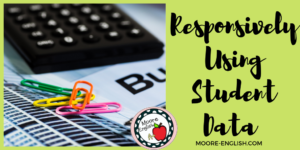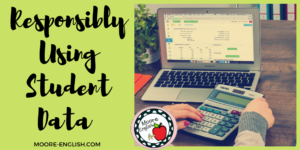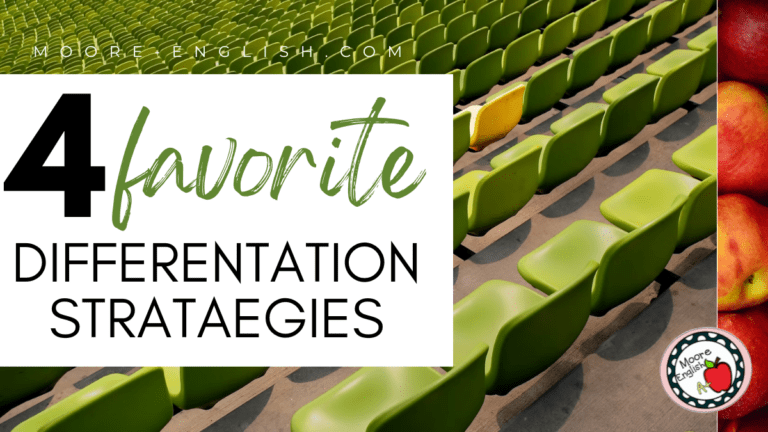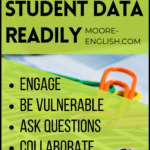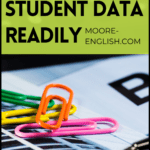On Tuesday, we discussed the advantages of using data to help students set, manage, and respond to their own goals. While assessment data has its limitations, and while teachers cannot know students through data alone, information is always power. And, as professionals, we must also use student data readily, responsively, and responsibly.
Using Student Data Readily
This post this post may contain affiliate links. Please read the Terms of Use.
In order to make the most out of data collection and analysis, teachers should consider some best practices for using data.
1. Engage data. As with most strategies, using data requires teacher buy-in. This means actively and promptly collecting and organizing data. Depending on your district or team, there may be norms in place to guide data discussions. If there are not expectations in place, establish some. Every practice is more effective when it’s goal guided. So establish some goals and norms for using data.
2. Demonstrate vulnerability. As teachers, we know our students well: what they’ve been through, home much they’ve grown, and how they respond in testing situations. In other words, we are close to our students. So sometimes we take their assessment data personally. However, for data collection and analysis to be effective, we have to take student data seriously but not personally.
From evaluating data, teachers should develop an understanding of their personal strengths as well as the strengths or their co-workers. This means that teachers can rely on one another for support. But asking for support requires vulnerability. However, such vulnerability indicates an ability and a willingness to change and grow.
Next Steps
3. Ask questions. The only stupid questions are unasked. So if the data-collection or analysis process proves challenging or unwieldy, ask for help. Similarly, if the data indicates a skills deficit in an area you know you’ve covered, ask for guidance. This guidance can come from co-workers, instructional coaches, or from students. Especially at the high-school level, students are almost always willing to give an opinion about how much they learned, including what details were confusing. In addition to asking questions, participating in an #observeme or in a peer-coaching cycle can also be a good way to ask questions targeted at specific aspects of your instruction.
4. Collaborate. Part of being vulnerable and asking questions is a willingness to collaborate with your co-workers. Sharing positive stories from the classroom can help build relationships between teachers. But asking for help from a co-worker provides them with a sense of empowerment that may carry over into their classroom.
5. Repeat. This is very important. But data-drive conversations are cyclical. Once you’ve finished one round of analysis, make some changes. And then it’s time to do another round of analysis. Check out teachers employing some of these strategies and determine how you can implement data analysis into your own pedagogy.
Responsively Using Student Data
In the past three years or so, my district has undergone serious transformations. One of the most important shifts in our thinking was using student data responsively. In the past, teachers would give a unit assessment, collect the data and reflect, and then move on. While summative assessment data is valuable, formative assessment data is more valuable because formative data is prescriptive.
After administering a formative assessment and analyzing the results, teachers should have an idea of how to alter instruction going forward. Sometimes the data suggests the entire class needs a new approach. But sometimes the data reveals two or three students with a specific struggle.
In this scenario, a small-group or individual lesson is warranted. Either way, the data requires a response from teachers. Responses to data can come from single teachers, teams, or departments. But data requires a response. Some kind of action is required. And passivity is not an option.
Responsibly Using Student Data
Finally, teachers must use data responsibly. While we are professionals, here are tenants to guide responsible data-drive discussions.
1. Tact. Student data is sensitive. So when hosting a data discussion, choose an appropriately private location. Consider who can hear you, who can access the data, and how the data will be shared so as to maintain its integrity and security. Similarly, since we can take student data personally, avoiding “you should…” statements can be helpful and can de-escalate a conversation. Instead of “you should,” consider asking questions.
- What does the data indicate?
- What strategies does the data suggest?
- And what opportunities does the data present?
- How would you advise a teacher or team in a similar situation?
2. Timeliness. As teachers, we know that students respond best to prompt and timely feedback. The same is true for data. The most relevant data is analyzed and discussed in a reasonable amount of time. Establishing a regular scheduling for collecting and discussing data can be key to successfully making critical changes.
3. Teaching experience. Finally, working responsibly with data requires an awareness of the experience of other teachers. The insights a new teacher gathers from data will be different from the insights a veteran teachers makes. Similarly, the veteran teacher may already know how to access her data before the new teacher has given the diagnostic. In addition, because we are at different levels, team leaders should model effective data collection and analysis attitudes.
How does your school handle data? What are your best practices for using data professionally? Let us know in the comments.




